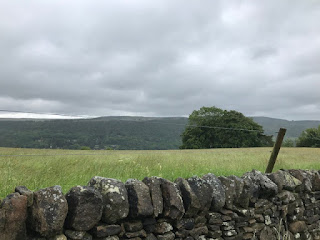A
lovely walk, but the blustery wind and the rain ever present in the
air did its best to put us off. However the intrepid walkers from St
Paul’s donned boots, rain jackets scarves and hats and set off from
the car park near the museum. In the event, the solid downpours on
the Manchester side of the Pennines left us alone.
Eyam
is often referred to as the Plague Village. During the 17th century
the villagers isolated themselves from the outside world as they were
decimated by the dreadful disease that killed off whole families in
quick succession.We
saw the evidence of this as soon as we began to walk through the
village as too many of the 17th century cottages have plaques listing
the names of those who had died.
The
walk took us out to the east of the village up a steep quiet road
until we reached more open country. We were rewarded with wonderful
views but also with the bleakness and isolation of the Riley Graves.
As we began our descent to the River Derwent we could see Curbar Edge
and Froggatt Edge in the distance. We then walked south along the
river, having first looked at Froggatt bridge which has arches of
unequal sizes.
We
turned west away from the river and climbing upwards on footpaths we
reached Stoney Middleton. This village is on a route to Sheffield and
Chesterfield and many people think it looks gloomy from the road as
they whizz through it. Approaching as we did, it emerges as a
beautiful ancient village. We passed the ‘alleged’ Roman Baths
before visiting the unusual Church of St Martin which is octagonal
and one of only two such churches in the country. From the village it
was a bit of a pull upwards to the Boundary Stone. During the Plague
food was left here for the Eyam villagers to collect without
contacting the ‘outside world’.
We
were soon back in Eyam and the welcoming warmth (and Cakes!) of the
Eyam tea rooms.
Eyam
is well worth a visit as is Stoney Middleton.
 |
| Riley Graves |
 |
| Froggat Bridge |
 |
| Ramblers - quick break |
 |
| Church of St Martin |
 |
| View over Peak District |
Comments
Post a Comment